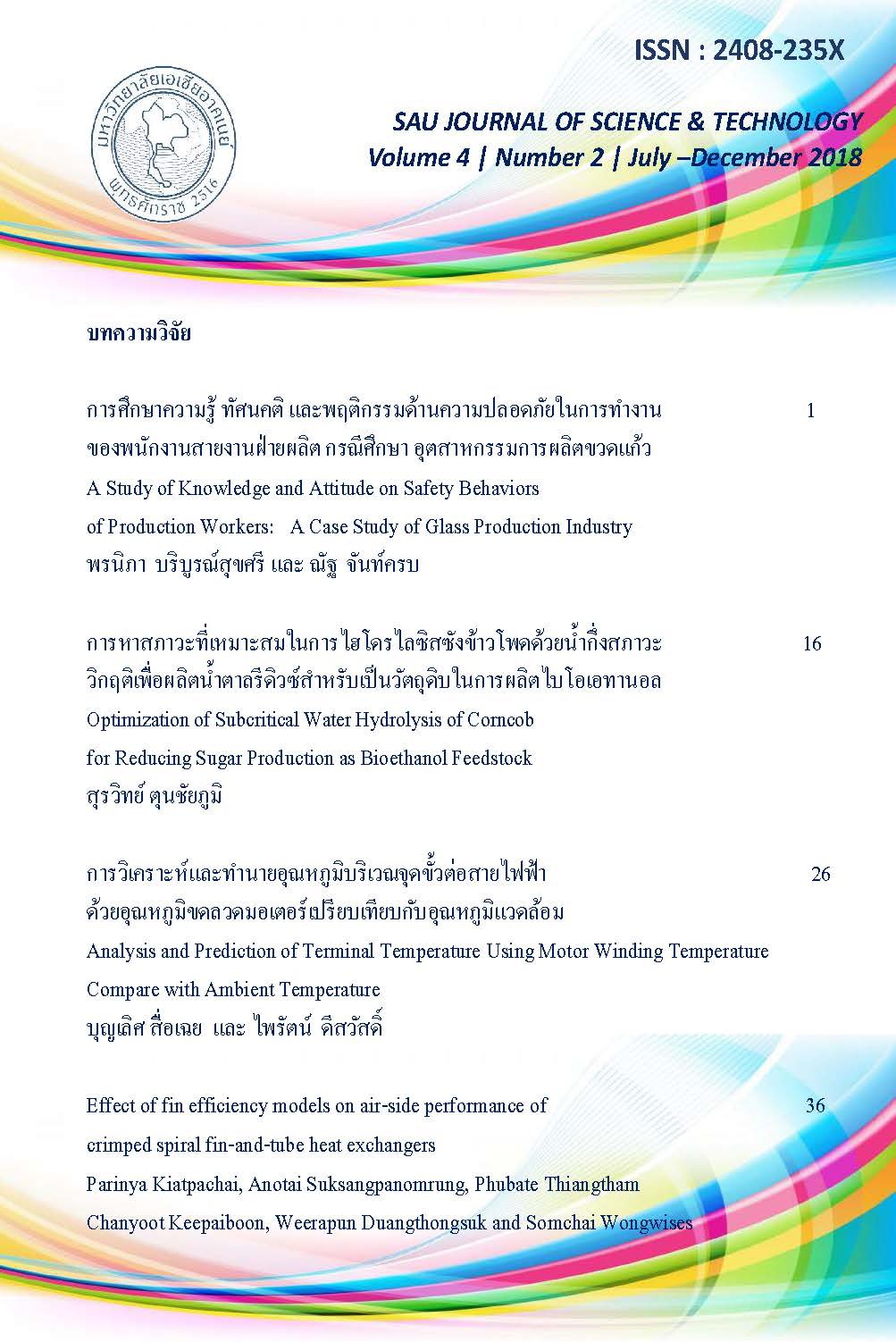A Study of Knowledge and Attitude on Safety Behaviors of Production Workers: A Case Study of Glass Production Industry
Main Article Content
Abstract
The objectives of this study were to knowledge and attitude on safety behaviors of 240 production workers at one of glass production companies. The research instrument used in the study was questionnaires with 4 sections that inquire about the following; general information, knowledge of safety, attitudes on safety, and safety behaviors. The study was analyzed using descriptive analysis, frequency, percentage, mean, standard deviation, ANOVA, and Pearson product-moment correlation coefficient with significance level of 0.05. The results of the study revealed that the levels of knowledge, opinions, and safety behaviors of the production workers were at the high level by exhibiting knowledge, safety opinions, and behaviors by 82.2%, 77.38%, and 75.44% respectively. The study also revealed that the production workers who manifested factors based on personal characteristics and injury experiences demonstrated different levels of safety knowledge. The correlation on safety showed that knowledge and behaviors had low correlated value of r=0.30(p-value < 0.05) while knowledge and opinions based on behaviors had a very low correlation levels of r =0.05 (p-value < 0.05) and 0.06 (p-value < 0.05), respectively. On the other hand, the positive opinions on safety were found to be not associated with the differences in personal factors. In conclusion, the results of this study could be applied in guidelines for further development of safety management systems and safety training for productions workers in the company.
Article Details
References
[2] ชัยยุทธ ชวลิตนิธิกุล. (2532). ความปลอดภัยในการทำงานสาหรับเจ้าหน้าที่ความปลอดภัยในการทำงาน. กรุงเทพฯ: เมฆาเพรส.
[3] กมลพัฒน์ ภูเงินขำ. (2552). ยุทธศาสตร์การพัฒนาพฤติกรรมความปลอดภัยในการปฏิบัติงานของพนักงานฝ่ายผลิต : กรณีศึกษา บริษัทควอลิติ้ คาร์ตอนส์ จำกัด จังหวัดสมุทรปราการ. วิทยานิพนธ์ปริญญามหาบัณฑิต, มหาวิทยาลัยราชภัฏราชนครินทร์.
[4] ศิริพงศ์ ศรีสุขกาญจน์. (2553). ความรู้ ทัศนคติต่อพฤติกรรมด้านความปลอดภัยของพนักงานอู่ทหารเรือพระจุลจอมเกล้า กรมอู่ทหารเรือ กรณีศึกษา : ในสายงานฝ่ายผลิต. วิทยานิพนธ์ปริญญามหาบัณฑิต, มหาวิทยาลัยธุรกิจบัณฑิตย์.
[5] ศิริลักษณ์ งิ้วใหญ่. (2556). ความรู้ ทัศนคติ พฤติกรรมความปลอดภัยในการทำงานและปัจจัยที่เกี่ยวข้องของพนักงานฝ่ายผลิต โรงงานอุตสาหกรรมรองเท้าในศูนย์พัฒนาชนบทผสมผสานจักราช. วิทยานิพนธ์ปริญญามหาบัณฑิต, มหาวิทยาลัยเกษตรศาสตร์.
[6] สุพล เลิศอุดมชัย. (2550). พฤติกรรมความปลอดภัยในการทางานของแรงงานในนิคมอุตสาหกรรมเกตเวย์ อาเภอแปลงยาว จังหวัดฉะเชิงเทรา. วิทยานิพนธ์ปริญญามหาบัณฑิต, มหาวิทยาลัยบูรพา.
[7] ] เสาวณีย์ เผ่าเมือง. (2554). พฤติกรรมความปลอดภัยในการทำงานของพนักงานฝ่ายผลิต บริษัท ซีทีเอส อิเล็กทรอนิกส์ คอร์เปอร์เรชั่น (ประเทศไทย). วิทยานิพนธ์ปริญญามหาบัณฑิต, มหาวิทยาลัยเทคโนโลยีราชมงคลธัญบุรี.
[8] Yamane, Taro (1973). “Statistics: an introductory analysis.” New York: Harper & Row.
[9] Likert, Rensis (1932). "A Technique for the Measurement of Attitudes". Archives of Psychology. 140: 1–55.
[10] DuPaul, G. J. (1991). “Parent and teacher ratings of ADHD symptoms: Psychometric properties in a community-based sample” Journal of Clinical Child Psychology, Vol.20, 245-253.


